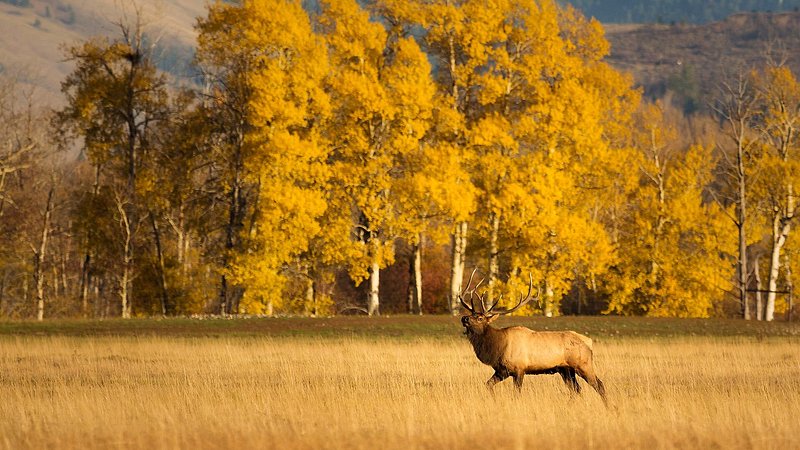Yes, you can go apple-picking inside a national park.
Leaf-peeping is an undeniably popular activity across America’s national parks each fall. But if you’re planning an entire vacation simply to stand with your mouth agape, marveling at the leaves—Instagram ready to go, of course—then you’re missing out on what makes the parks so special, especially come autumn.
Visiting after the summer high season crowds have dispersed is the perfect way to engage with the parks, whether you’re paddling or fishing on their waterways, communing with their wildlife, or tackling their backcountry trails. And those crimson maples and golden aspens? They’re just an added bonus—a colorful backdrop to all your park pursuits.
Here, seven activities to try while admiring fall foliage in the US national parks.
Fish for trout in Rocky Mountain National Park, CO
In the Rockies, the biggest fall spectacle is the aspens, which turn golden and famously “quake,” giving the appearance of a forest full of shimmering sequins. Due to its high elevation, fall foliage begins to appear in Rocky Mountain National Park as early as late August, but to experience the peak, you’ll want to visit from late September to early October. (Aspens can be viewed nearly everywhere in the park, but some of the most popular spots include Hidden Valley, along Bear Lake Road, or on the Glacier Gorge Trail up to Alberta Falls.)
That timing also coincides with the tail end of trout-fishing season, when brown, brookies, and rainbows are plentiful; you may also land a greenback cutthroat or Colorado River cutthroat, two indigenous trout species that the parks department has helped return to these waters since the 1970s. If you don’t want to go it alone, book a guided fly-fishing experience with Estes Angler or stop into their shop in Estes Park for fishing licenses, waders, and everything else you’ll need.
Where to stay: The newest hotel in these parts is Trailborn Rocky Mountains, a boutique spot where you can book a guided experience with Sasquatch Fly Fishing or an aspen-and-elk photography hike. On certain Fridays, the hotel’s restaurant hosts complimentary tastings of Colorado-distilled spirits.
Pick apples in Capitol Reef National Park, Utah
Near the visitor center of this red-rock wonderland, you’ll find orchards that date back to the appropriately named community of Fruita, which was settled in the 1880s by Mormon pioneers. Today, there are about 1,900 trees, including apricots, peaches, pears, apples, mulberries, and a variety of nuts—many of which are available for picking by visitors. The latest crops ready to harvest are apples, which peak from mid-August to mid-October, but remember to bring cash! Orchards with ripe fruit will be marked with a “U-Pick Fruit” sign, and after you’ve collected your haul, you’ll need to stop by the self-pay station, which is equipped with a scale and a list of fruit prices.
If you time your visit correctly, you can come for the fruit and the foliage: Mid-October is also when the yellow cottonwoods and box elder peak, and you may still catch aspens, which hit their golden stride earlier in the month. While you’re here, stop into the Gifford Homestead for preserves, ice cream, and especially the locally baked fruit pies.
Where to stay: At the Capitol Reef Resort, guests can choose from traditional rooms, cabins, or glamping experiences, which come in the form of Conestoga wagons and teepees.
Go paddling in Acadia National Park, Maine

Foliage in Acadia tends to peak between October 13 and 22, and it’s best to take it in from a loon’s-eye view as you canoe or kayak on the park’s famed waterways, such as Eagle Lake and Jordan Pond. If your home base doesn’t already include gear, there are plenty of options for rentals, including National Park Canoe and Kayak Rental, which sits at the northern tip of Great Long Pond, and Acadia Outfitters, which also offers guided sea-kayaking tours through waters teeming with porpoises and harbor seals.
Where to stay: Completely renovated and reopened last year, the 1940s-era Salt Cottages are undoubtedly made for summer fun, but there’s plenty to enjoy before the cottages close in late October, including a roaring stone fireplace in the lobby and nightly s’mores by the firepit. Oh yeah, and a pair of hot tubs.
Bike in Cuyahoga Valley National Park, Ohio
The wildly accessible Cuyahoga Valley National Park hugs the Cuyahoga River between Cleveland and Akron, and among its highlights is the Ohio & Erie Canal Towpath Trail. About 20 of its 100-plus miles are found within the park’s boundaries, and it runs along a path that mules used to walk on while towing canal boats out to the frontier.
These days, the tree-lined path is perfect for biking, and you can rent a set of wheels from Century Cycles in Peninsula or Outspoken E-bike Rentals or Blimp City Bike & Hike in the Akron area. Because there are so many types of deciduous trees in the park, you’ll be able to witness an ever-changing display no matter when you come in October, starting with sugar and red maples, continuing with white and pin oak, and finishing with late-turners like hazelnut and witch hazel.
Where to stay: For an elegant stay within the park, check out The Inn at Brandywine Falls, a converted home from the 1850s. Particularly cozy are the suites in the carriage barn—the Granary Suite and the Loft Suite—which include hand-hewn beams, whirlpool tubs, and expansive windows overlooking a hemlock grove.
Travelers say: “We were a family of four with two young kids and had a perfect weekend at the Inn. Kids under six aren’t allowed in the main house so we stayed in the Loft… Not the most childproofed as my toddler loved climbing the staircase but it was spacious and comfortable. …Location is excellent, as we were able to just walk to the Brandywine Falls from the yard of the inn.”—@plural39
Watch the elk rut in Yellowstone National Park, WY, MT, and Idaho

During their autumn “rut,” or mating season, Yellowstone’s elk population moves into the northern range, before migrating for the winter, traditionally beyond the park. From early September to mid-October, just as the park’s foliage is hitting its stride, the massive elk put on an equally ostentatious display: You’ll often catch bulls, which can weigh up to 700 pounds, issuing piercing bugling calls and challenging competitors to violent-looking antler duels for a mate. The best places to see them are along the Madison River or near Mammoth Hot Springs, and you can even catch them on the lawn at the Albright Visitor Center, where rangers are on hand to tell you more about the ritual. Best of all, autumn means significantly fewer visitors than during the summer, as lodging starts to close up before snow arrives.
Go for a mule ride in Grand Canyon National Park, AZ
You might not immediately think of the Grand Canyon as a fall foliage hot spot, but the higher-elevation North Rim is dotted with birches, oaks, and aspens—all of which look especially stunning against the canyon. Peak foliage begins as early as late September, which comes in handy, because the lesser-visited side of the canyon shuts down for the winter soon after, with retail, lodging, and food services closing shop by October 15. One of the most peaceful ways to take in the scenery before the North Rim closes for the season is on a mule with Canyon Trail Rides; itineraries range from one to three hours and include routes that dip down into the canyon to Supai Tunnel.
Where to stay: The Grand Canyon Lodge was designed by renowned architect Gilbert Stanley Underwood in the 1920s and features massive ponderosa pine beams and a limestone facade that immediately screams “national park.”
Chase waterfalls in Shenandoah National Park, VA

Encompassing nearly 200,000 acres of Blue Ridge Mountains wilderness, Shenandoah National Park practically glows in the autumn, with fall foliage colors peaking above 3,500 feet in early October and then slowly spreading down to lower elevations throughout the rest of the month. The easiest way to take them all in is on a leisurely cruise down the 105.5-mile Skyline Drive, but if you want to get in among the trees, ditch your car in one of the many parking lots and hike down to one of the park’s iconic waterfalls. Be sure to check the NPS website for the various routes, which vary considerably in length, steepness, and difficulty: The Dark Hollow Falls trail is extremely popular and relatively short (it takes about one to two hours), but the return journey back up to the parking area is steep and challenging, while the nearby Rose River Falls hike takes you to wide, 67-foot-high cascades that burst to life, particularly after heavy rains.
Travelers say: “[Be sure to] start with a full tank of gas. Gas stations are very limited along the parkway. [And] purchase your park pass online. It will make your entrance into the park much faster, bypassing all those who have to stop and pay to enter!”—@RoadForks
Where to stay: You can’t get more surrounded by nature than at Getaway Shenandoah, a collection of tiny modernist cabins with an onsite nature trail that winds through cedar and sycamore forests.




